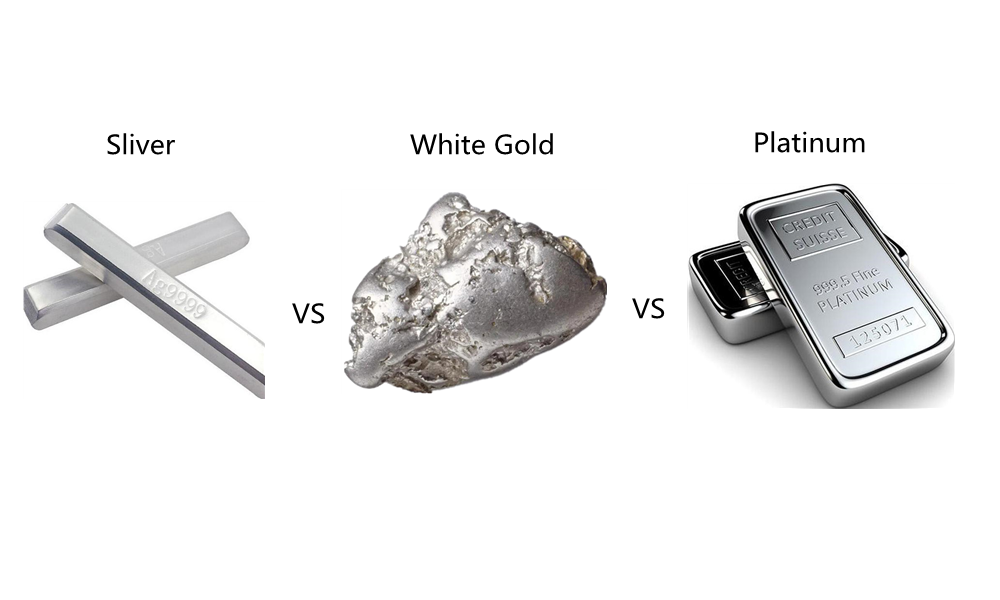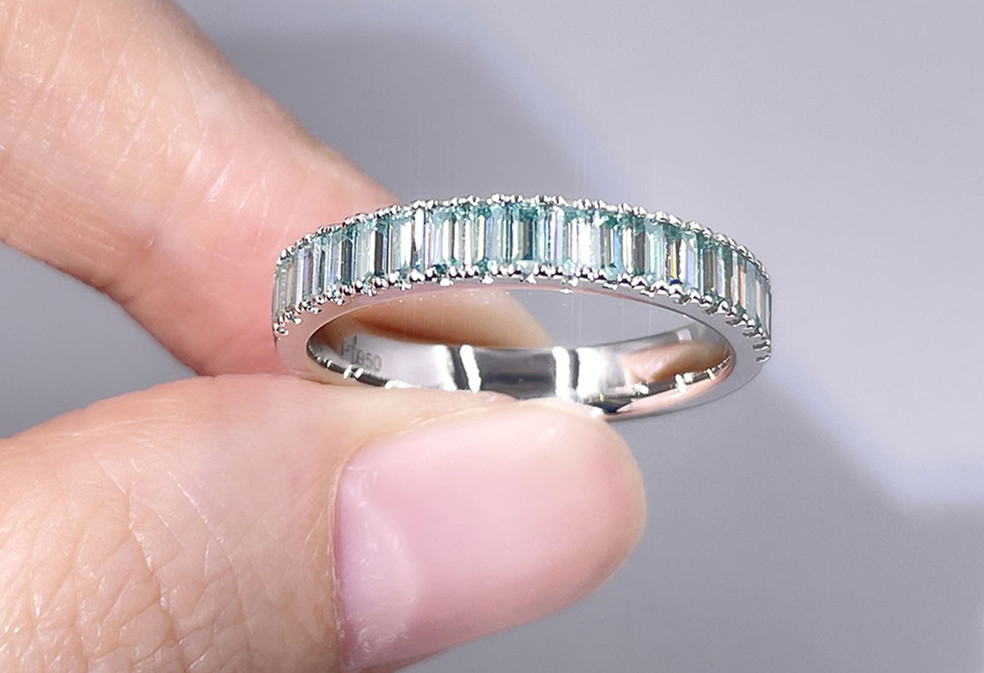
Distinguishing between platinum, silver, and white gold can be challenging, as these metals can look quite similar at first glance due to their silver-white appearance. However, several key characteristics and testing methods can help you tell the difference between them:

1. Weight
The weight of platinum, silver, or white gold jewelry is an obvious indicator to help you differentiate between these metals, platinum is heavier than white gold and white gold is heavier than silver. Let's explore the weight differences among these precious metals:
Platinum: Platinum is known for its substantial weight. It is significantly denser and heavier than both silver and white gold. When you hold a piece of platinum jewelry in your hand, you'll immediately notice its weight, which is one of its distinctive characteristics.
Silver: Silver, while not as heavy as platinum, still has a moderate weight. When you handle silver jewelry, you can feel a certain heft, but it's lighter than platinum. This weight can vary slightly depending on the thickness and design of the jewelry piece.
White Gold: White gold falls between platinum and silver in terms of weight. It is lighter than platinum but slightly heavier than silver. The weight of white gold jewelry is influenced by its gold content and the other metals alloyed with it.
Considering the weight of jewelry can be helpful when trying to differentiate between these metals, especially if you have multiple pieces to compare. The weight, combined with other factors like color and hallmarks, can provide valuable clues about the metal used in a particular piece of jewelry.
2. Color and Luster
The color and luster of jewelry made from platinum, silver, or white gold are key factors that contribute to their visual appeal and can assist you in distinguishing one from another. Let's delve into how color and luster vary across these precious metals:
Platinum: Platinum is renowned for its stunning, bright white color. It possesses a natural luster that doesn't fade over time. One of the exceptional qualities of platinum is its ability to maintain its brilliant white appearance, making it an ideal choice for jewelry that retains its allure without the need for frequent polishing.
Silver: Silver jewelry exhibits a distinct and radiant white color, much like platinum. However, silver is susceptible to tarnishing when exposed to air and moisture. This tarnish can diminish its luster, resulting in a slightly dull or matte appearance. To restore its shine, regular cleaning and polishing are required.
White Gold: White gold, as its name suggests, also features a white color similar to that of platinum and silver. However, white gold may have a subtle yellowish undertone due to its gold content. To enhance its whiteness, white gold jewelry is often coated with rhodium, a precious metal that provides an exceptional luster and brilliance. Over time, this rhodium plating may wear off, revealing the slightly yellowish hue of the underlying white gold.
When choosing jewelry, consider your preference for color and luster, as well as the level of maintenance you're willing to undertake. While platinum maintains its white brilliance effortlessly, both silver and white gold may require occasional cleaning or re-plating to preserve their luster and color.

3. Hallmarks and Stamps
To help determine the authenticity and composition of jewelry made of platinum, silver, or white gold, it's essential to inspect for hallmarks and stamps. These markings can provide valuable information about the metal used. Here's what you need to know:
Platinum: Authentic platinum jewelry typically features specific hallmarks that indicate its purity. Look for markings such as "950 Plat" or "Pt950." The "950" signifies that the jewelry is 95% pure platinum, a common standard for platinum jewelry. These hallmarks are often found on the inside of the jewelry piece.
Silver: Genuine silver jewelry is usually stamped with hallmarks like "925" or "Sterling Silver." The "925" indicates that the piece contains 92.5% pure silver, with the remaining 7.5% being other metals. These hallmarks are valuable indicators of silver authenticity.
White Gold: White gold jewelry often displays markings like "14k" or "18k," followed by "WG" or "White Gold." The "14k" or "18k" denotes the gold content in the alloy, with "14k" representing 58.3% pure gold and "18k" representing 75% pure gold. The "WG" or "White Gold" stamp confirms the metal's composition. sometimes also stamp Au585 or Au750.
When examining jewelry for hallmarks and stamps, be sure to check the inside of rings, clasps, or other inconspicuous areas where these markings are typically placed. These hallmarks serve as reliable indicators of the metal's authenticity and can assist you in making informed purchasing decisions.

4. Price
When considering jewelry made of platinum, silver, or white gold, price is often a crucial factor. These metals vary significantly in terms of cost, making it essential to understand their price ranges:
Platinum: Platinum is the most expensive among these three metals. Its rarity and purity contribute to its high price tag. If you're looking for a luxurious and enduring option, be prepared to invest more in platinum jewelry.
Silver: Silver is known for its affordability, making it an excellent choice for budget-conscious buyers. You can find a wide range of silver jewelry options that cater to various price points.
White Gold: White gold falls between platinum and silver in terms of pricing. It offers a balance between quality and affordability. While it's more expensive than silver, it is generally more budget-friendly than platinum.
Keep in mind that the price of jewelry can also vary based on design, craftsmanship, and gemstone embellishments. When shopping for jewelry, consider your budget and preferences to choose the metal that aligns with both your financial constraints and your desired aesthetic.

5. Allergies
When it comes to choosing jewelry, it's not just about style; it's also essential to consider any potential allergies. Some individuals may have sensitivities to certain metals used in jewelry. Let's explore how platinum, silver, and white gold fare in terms of allergies:
Platinum: Platinum is known for being hypoallergenic. It rarely causes allergic reactions, making it an excellent choice for individuals with sensitive skin. You can wear platinum jewelry with confidence, knowing it's unlikely to trigger any skin issues.
Silver: Silver, in its pure form, is generally safe for most people. However, some individuals may be allergic to silver jewelry, particularly if it contains nickel. Nickel allergies are relatively common. If you suspect you have a nickel allergy, opt for silver jewelry that is labeled as nickel-free or choose alternative metals.
White Gold: White gold jewelry can potentially contain nickel, which is a common allergen. If you have a nickel allergy, it's crucial to inquire about the composition of the white gold jewelry you intend to purchase. Some white gold alloys use palladium instead of nickel, making them a safer choice for those with sensitivities.
Understanding your metal allergies is essential for ensuring a comfortable and enjoyable wearing experience. If you have known allergies to specific metals, always check the composition of your jewelry and choose hypoallergenic options when necessary.

6. Maintenance
Jewelry, whether it's made of platinum, silver, or white gold, requires care and maintenance to retain its beauty and shine over time. Let's explore the maintenance considerations for each of these precious metals:
Platinum: Platinum is known for its low maintenance requirements. It doesn't tarnish or lose its shine, which means you won't need to polish it frequently. However, like all jewelry, platinum can accumulate dirt and oils from daily wear. To keep it looking its best, gently clean it with a mild soap and a soft brush or cloth. Professional cleaning by a jeweler is also an option for more thorough maintenance.
Silver: Silver jewelry, while stunning, is prone to tarnishing due to its reaction with sulfur compounds in the air. To maintain its luster, regular cleaning is necessary. You can use a silver polishing cloth or a specialized silver cleaning solution to remove the tarnish and restore its shine. Proper storage in a tarnish-resistant bag or cloth can also help prevent tarnishing between wears.
White Gold: White gold jewelry may require occasional maintenance to preserve its white color. Many white gold pieces are rhodium-plated to enhance their whiteness. Over time, this plating can wear off, leading to a slightly yellowish tint. If you notice your white gold jewelry losing its brightness, you can have it re-plated with rhodium by a professional jeweler. Regular cleaning with mild soap and a soft brush or cloth will help maintain its appearance between re-plating.
Understanding the maintenance needs of your jewelry is essential for keeping it in excellent condition. Regardless of the metal you choose, a little care and attention can ensure your precious pieces continue to shine and sparkle for years to come.

7. Magnet Test
When trying to distinguish between platinum, silver, and white gold, you can perform a simple magnet test. This test helps identify whether the metal in question is magnetic or not. Here's what you need to know:
Platinum: Platinum is not magnetic. When you bring a magnet close to a platinum item, you won't observe any attraction or movement. This is a useful characteristic to confirm the presence of platinum.
Silver: Silver, like platinum, is also non-magnetic. When exposed to a magnet, a silver object will not be attracted to it. This property is consistent with pure silver.
White Gold: White gold, in most cases, is not magnetic either. However, there can be exceptions. If white gold contains other metals in the alloy, such as iron, it may become weakly magnetic. To perform the magnet test on white gold, hold a magnet close to the item and observe if it exhibits any attraction. Keep in mind that the weak magnetism may not be easily noticeable.
The magnet test is a quick and handy way to help distinguish these precious metals. Remember that while it can provide valuable information, it should be used in conjunction with other methods, such as examining hallmarks and considering the metal's weight and appearance, to make a more accurate determination.

8. Nitric Acid Test
Another method for distinguishing between platinum, silver, and white gold is the nitric acid test. This test involves observing how each metal reacts when exposed to nitric acid. Here's what you need to know:
Platinum: Platinum is highly resistant to nitric acid. When you apply nitric acid to a platinum item, you'll notice no significant reaction. This resistance to corrosion and chemical reactions is one of platinum's defining characteristics.
Silver: Silver, on the other hand, reacts with nitric acid. When silver comes into contact with nitric acid, it undergoes a chemical reaction that turns the metal surface milky or cloudy. This reaction is a clear indicator that you are dealing with silver.
White Gold: White gold may or may not react to nitric acid, depending on its composition. If the white gold alloy contains nickel, it will typically turn greenish when exposed to nitric acid. However, if it doesn't contain nickel, it may exhibit a minimal or no reaction.
The nitric acid test is a more advanced method used by experts to differentiate these metals. It's essential to exercise caution when conducting this test, as nitric acid is a corrosive substance. If you're not experienced with chemical testing, it's best to rely on other methods, such as examining hallmarks and using the magnet test, to identify the metal.
Distinguishing between platinum, silver, and white gold involves examining key characteristics such as density, hallmarks, and their individual attributes. While platinum stands out as the epitome of luxury, silver offers timeless elegance at a more affordable cost, and white gold provides a contemporary alternative with its own unique charm. Whether you seek the enduring prestige of platinum, the classic allure of silver, or the modern elegance of white gold, each metal has its place in the world of fine jewelry, ready to adorn and enchant.
Copyright ©2025 Wuzhou Tianyu Gems Co., Ltd - All Rights Reserved.